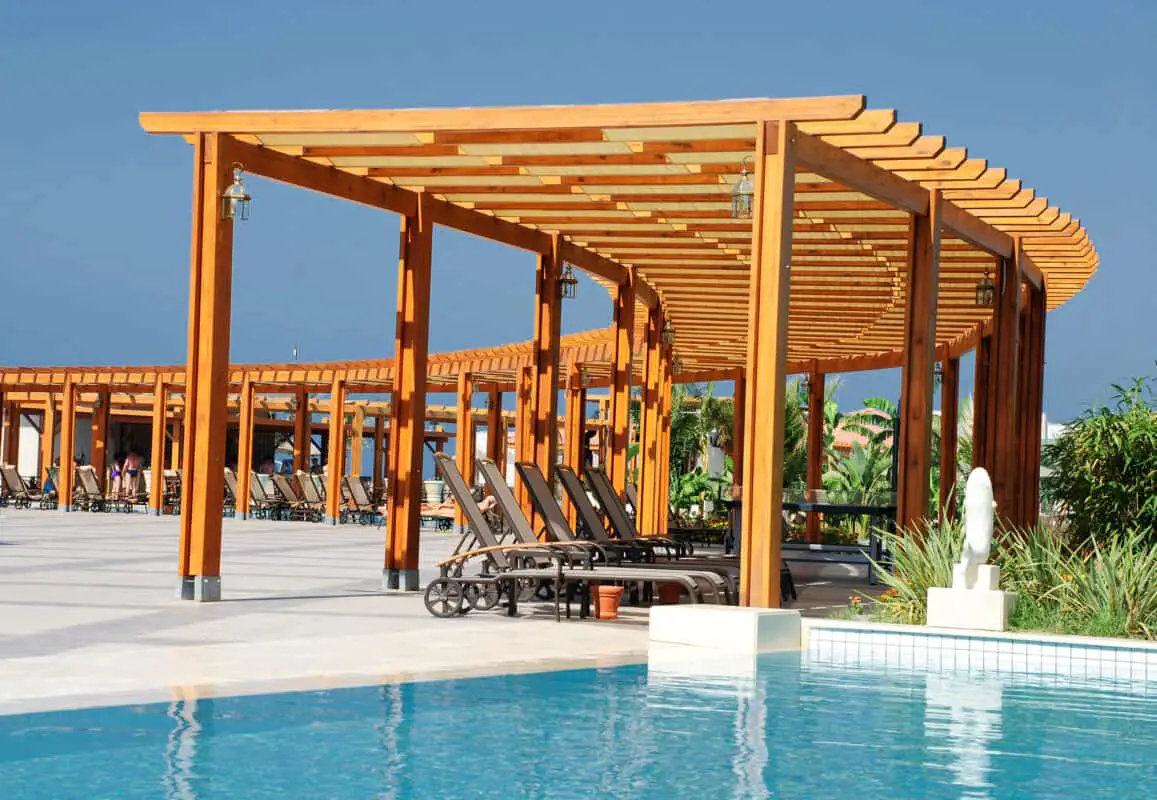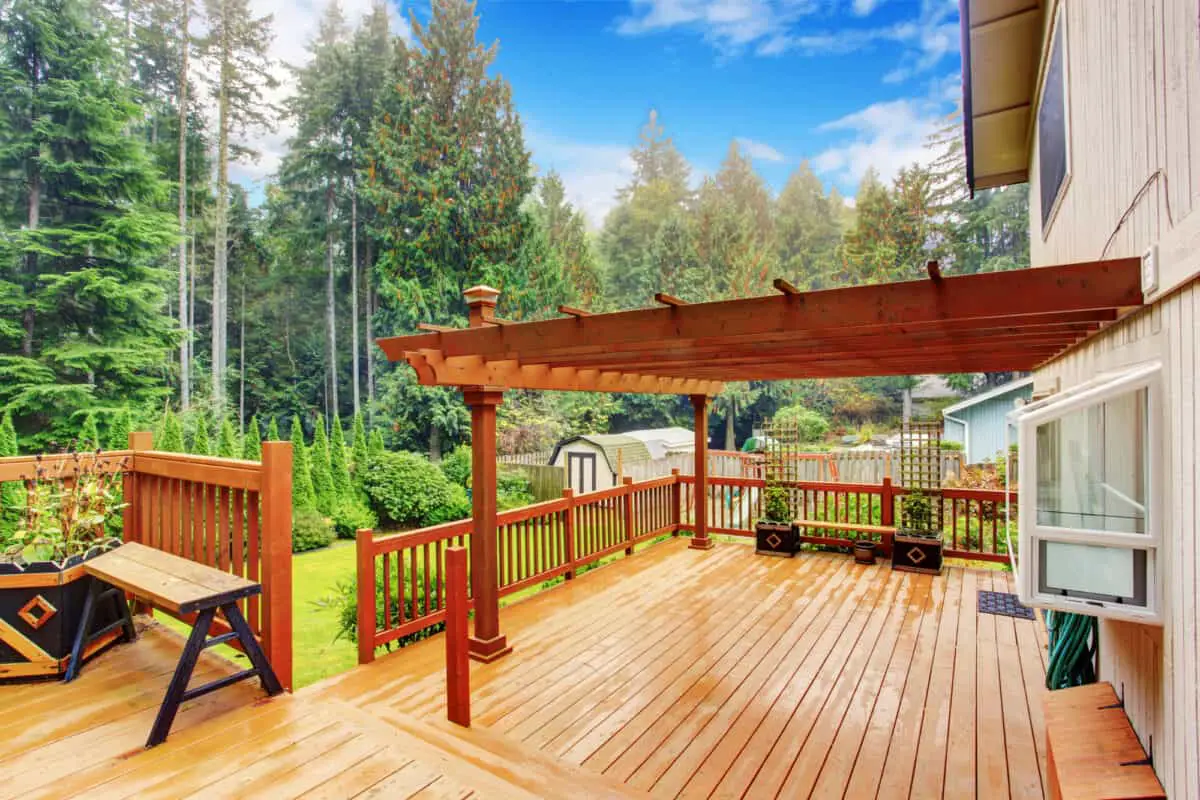Creating a shaded or covered area over a deck or patio with a stylish pergola is a great idea. It’s essential to choose the best type of wood for your pergola.
These are the top choices for the best wood for your pergola.
- Pressure Treated Wood (PT)
- Cedar Wood
- Tropical Hardwood
- Thermally Modified Wood
If you’re considering building a pergola in your home’s backyard or constructing one for outdoor seating at your business, you’ll appreciate the beauty of a well-built pergola.
One great advantage of having a pergola is that it can provide shade without the need for a roof.
While gazebos are popular in colder climates because they offer protection from snow and rain, pergolas are ideal for warmer weather.
With some simple modifications, your pergola can provide shade from the sun and protect you from light rain. There are numerous options available for shelter, ranging from a louvered roof to a canopy.
Pergolas can have many different looks, with rustic and modernized styles being among the most common.
One of the advantages of using wood for pergolas is its versatility.
You can either paint or stain it, or let the natural weathering process give it a beautiful distressed look.
Pergolas are a great way to create a peaceful outdoor area to relax. To find out which type of wood is best suited to your project and requirements, read on!

Table of Contents
What to Consider When Choosing the Best Wood For Your Pergola
When choosing, the first thing to consider is your location. Do you reside in a cold and dry climate with low precipitation, or do you live in a region with high temperatures and significant humidity?
Choosing the right type of wood is crucial, especially depending on your location. While wood may look beautiful, it could become infested with insects or easily rot if exposed to excessive rain.
When selecting the best wood for your pergola, it’s important to consider the amount of weight it will be supporting.
While some woods may have an appealing appearance, they may not be strong enough to withstand heavy stress loads.
If you plan on constructing a smaller pergola with an open roof, it’s possible to use lighter-load wood.
However, if your intention is to build a louvered or solid roof and attach ceiling fans and/or heaters, you’ll need to use higher load-tested wood.
This is important for ensuring the safety and stability of the structure.
If you’re planning to add vines for a beautiful outdoor aesthetic, make sure to consider the best wood for your pergola that uses stain or paint.
You want to select which would best complement the look while also providing protection for the pergola with the attached growth.
After evaluating the outdoor environment, weight capacity, aesthetics, and natural growth placement, it’s time to factor in the cost of the wood to ensure the pergola project stays within budget.
In order to assist in selecting the optimal material for your pergola, we offer four different wood options to consider.
Pressure Treated Wood (PT)
If you’re not too concerned about the appearance, pressure-treated wood is a budget-friendly option for building pergolas.
However, it does come with some drawbacks.
Chemicals are used to make the wood resistant to rot, decay, and insects, which can leave an unsightly stain. This may not appeal to everyone.
While pressure-treated wood is economical, its coloring can have a blue or green tint that may seem unusual and unattractive to homeowners.
As a result, many choose to paint or stain it in a different color.
Personally, I believe that instead of spending additional funds on fixing the coloring of inexpensive wood for your pergola, it would be wiser to invest in high-quality wood such as red cedar or redwood.
Cedar Wood
Cedarwood may be more expensive than pressure-treated wood, but it is naturally protected and strong.
Originating from Canada, cedar is a durable option suitable for various climates, especially harsher ones due to its ability to withstand extreme temperatures and repel dirt, insects, rot, and decay without any added chemicals.
If you choose cedarwood as the best wood for your pergola, you have the choice to paint or stain it to your liking.
However, if you let it weather naturally, it will eventually turn a greyish color.
Although cedarwood may be pricier than pressure-treated wood, it’s a natural option without any chemicals used for treatment.
Tropical Wood
A popular choice for those seeking tropical wood is Ipe. While it can be costly and challenging to come by, it offers an appealing and long-lasting option.
For outdoor projects, tropical timber is often viewed as the top choice.
As a particular kind of tropical hardwood, Ipe can withstand even the saltiest water, making it an excellent selection for a pergola.
Ipe wood is highly resistant to weathering and is also resistant to insects, dirt, rot, and decay, just like many other types of wood.
The workability of Ipe tropical wood is remarkable when compared to cedar or pine wood.
It has been reported that the pier at New York City’s Coney Island is entirely constructed of Ipe hardwood and has lasted 25 years without requiring any maintenance.
Thermally Modified Wood
If you want the perfect combination of great looks, affordability, and high performance, then thermally modified wood is the best wood for your pergola.
The wood is subjected to a scientific process called thermal modification, which changes its cellular properties, chemistry, structure, and overall performance.
Thermally modified wood is more stable than other woods because it undergoes a process of superheating.
This process essentially “cooks” the natural sugar in the wood. This makes the wood highly resistant to rotting and decay.
Thermally modified wood offers a major advantage in terms of stability and could be an ideal choice for your pergola.
Its stabilization properties prevent shrinkage or expansion in varying temperatures, resulting in a reliable outdoor structure that requires minimal maintenance.
Maintaining and Cleaning Your Pergola
Keeping your pergola clean and well-maintained doesn’t have to be a difficult task.
If you’ve opted for one of the popular or higher-quality wood options mentioned above, you’re in luck.
The natural properties of the wood offer great protection against the elements.
However, it’s important to regularly clean and maintain the wood to prevent termite infestations.
As time passes, the wood used to construct your pergola may experience wear and tear.
To prevent this, you can apply a clear oil-based sealant. This will protect the wood from harsh weather conditions in your area.
You can reapply the sealant every two to four years if necessary, which will help to maintain the quality of your pergola.
If your pergola is not treated or cared for properly, the wood may rot and deteriorate faster than expected. This could lead to costly replacements for your entire patio cover.

Conclusion
In the present day, there are various types of wood that can be used to construct pergolas.
However, the choice ultimately depends on the desired appearance and intended use of the pergola.
In essence, pergolas are typically constructed using wood as it is easily accessible at local hardware stores.
There is a common belief that working with wood for pergolas is both durable and straightforward.
Using wood as a material for outdoor conditions can be beneficial due to its durability. It also offers flexibility when it comes to adjusting sizes and customizing designs to meet your specific needs.
When deciding on the best wood for your pergola, consider how long you want it to last and how much upkeep it will require.
Think about what you want to gain from your pergola and choose a wood, color, and look that will suit your preferences.
This will ensure that your structure is visually appealing and meets your needs for a long time.
Enjoy living the outdoor life!!!
